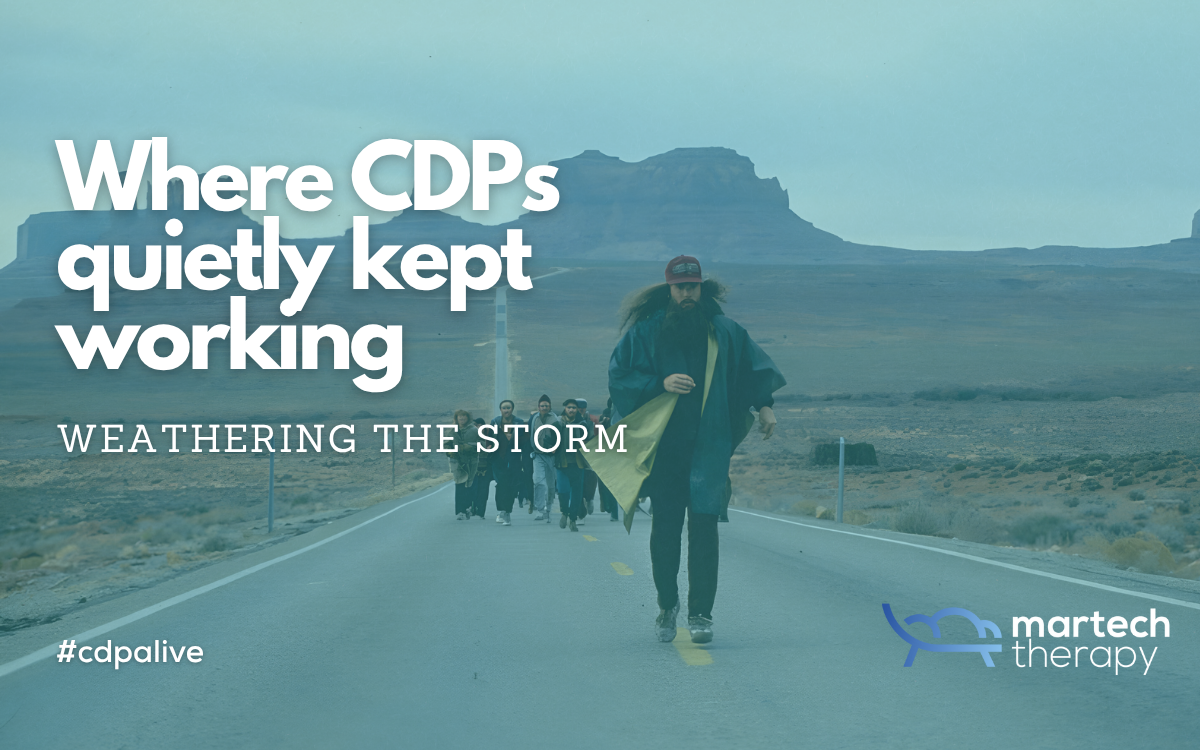Every few months, someone posts another chart about the end of Customer Data Platforms. The logos change, the arrows move toward “composable,” and the takeaway is always the same *drum roll* the category is over. But when I look at what’s actually running inside mid-market marketing stacks, where I spend most of my days, the story doesn’t match the headline.
The parts that never stopped working
What’s survived isn’t the marketing copy, that changes as often as the wind, but it’s the machinery. Ingestion, identity resolution, consent collection, and segment activation, those functions never disappeared. They were simply folded into other systems. Customer Engagement Platforms borrowed a handful. DinMo's Olivier Renard recent CDP vs CEP piece dives into it more. Data warehouses took over storage and activation. And many mid-market CDPs just kept doing their job quietly, one integration at a time.

When you strip away the category debates, a pattern appears. The companies that kept their CDPs alive weren’t chasing transformation budgets. They were solving for continuity. Making sure data kept flowing between tools, even as vendors rebranded their way through Gartner quadrants.
What the mid-market understood
Most mid-market teams didn’t buy into the idea of the CDP as a grand unifying theory. They bought it as a workflow tool. A way to connect the places where customer data lives with the places where it’s needed. They care less about architecture diagrams and more about the two hours saved every week when a list doesn’t have to be exported manually.

It’s not that these teams ignored innovation, but they just had a different definition of progress. For them, stability and predictability were the real modernisations. A composable stack is interesting until someone has to maintain it. The CDP that quietly works every day feels like a relief.
A smaller, sharper scope
There’s something pragmatic about how the mid-market uses CDPs today, that much needs to be said. Most implementations focus on three things:
- reliable IDs
- permission management
- campaign activation
No dashboards full of AI intent scores or 360-degree promises. They have not reached that station, yet. Just data that’s accurate enough to act on. The rest lives elsewhere, often inside the CEP or warehouse. And that’s fine.
This narrower scope is why CDPs in this segment tend to survive economic cycles better than their enterprise cousins. They don’t depend on transformation budgets or internal evangelists. They exist because they make something else easier, such as reporting, targeting, compliance, or collaboration.
The quiet evolution
It’s easy to say CDPs lost ground to warehouses or to engagement suites. In practice, they evolved together. The boundary between these tools is porous by design. Warehouses grew activation muscles thanks to various companies that dared to challenge the status quo. In that slipstream, CEPs built simple profile stores. And CDPs, starting to feel the pressure, added outbound connectors and analytics. The convergence wasn’t a takeover in a direct sense, but more a slow migration toward whatever solved the most immediate pain.
When people talk about “embedded CDPs”, a term I heard a few weeks ago from my peer Lee Hammond after he read my first article, this is what they mean. The underlying data logic that now lives inside other platforms. The form has changed, but the functions are familiar. That’s why when someone declares CDPs dead, most mid-market practitioners just shrug. They’re still using one, even if the vendor calls it something else.
Why that matters
If there’s a lesson here, it’s that usefulness outlasts naming. Maybe that's the game that Salesforce is playing... The CDP may no longer sit at the center of every martech diagram. Still, it remains a core idea, an operational layer for unified, privacy-ready customer data, that has quietly become a default expectation. You don’t need to justify it anymore. You just need to decide where it lives.

For mid-market teams, that’s the win. They’re not chasing architectural purity or future-proof tech. They’re running campaigns, staying compliant, and keeping their data in order, working with the resources they have available. In that sense, the CDP never died. It just stopped introducing itself so loudly.
In the next article, I’ll look at where these functions are headed next: CEP/CDP hybrids, warehouses with activation layers, and the practical trade-offs behind building versus adopting them.



Discussion